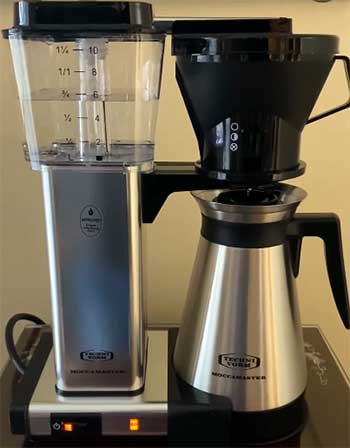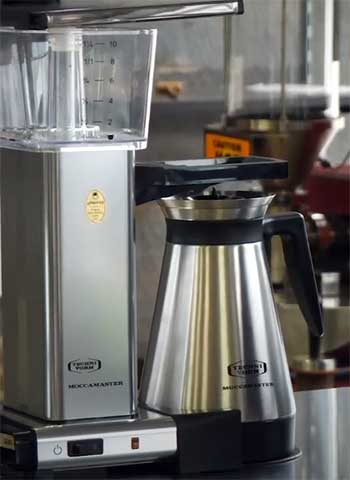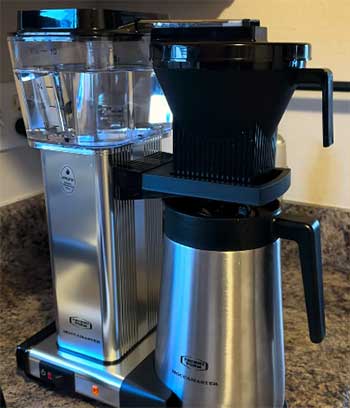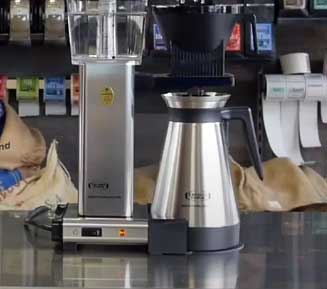I’m a coffee enthusiast who’s spent years chasing the perfect cup, and I’ve found myself captivated by the Technivorm Moccamaster. Specifically, I’ve been torn between the KBT and KBGT models, both promising that rich, aromatic pour-over experience without the hassle.
In this article, I’ll share my firsthand insights, comparing these two stellar coffee makers to help you decide which one deserves a spot on your counter. From their design to their brewing prowess, I’ll break down the pros, cons, and key features to guide your choice.
A Brief Comparison Table
| Feature | Moccamaster KBT | Moccamaster KBGT |
| Carafe Type | Thermal (Stainless Steel, Double-Walled) | Thermal (Stainless Steel, Double-Walled) |
| Capacity | 1.25L (40 oz, 10 cups) | 1.25L (40 oz, 10 cups) |
| Drip-Stop | Manual (3-position switch: open, half, closed) | Automatic (stops when carafe is removed) |
| Brewing Time | 4-6 minutes | 4-6 minutes |
| Brew Control | Manual adjustment for flow rate | Fully automatic, no flow adjustment |
| Height | 35.6 cm (14 inches) | 38.1 cm (15 inches) |
| Price (USD) | ~$349 | ~$349 |
| Best For | Hands-on brewers, partial pots | Full-carafe brewers, simplicity seekers |
| SCA Certification | Yes | Yes |
| Warranty | 5 years | 5 years |
My Coffee Journey With Moccamaster

I’ve always been picky about my coffee.
There’s something magical about that first sip in the morning—bold, smooth, and just the right temperature.
After years of experimenting with French presses, pour-overs, and cheap drip machines, I decided it was time to invest in something serious.
That’s when I stumbled upon the Technivorm Moccamaster, a Dutch-made coffee maker revered for its precision and durability.
The KBT and KBGT caught my eye, both boasting thermal carafes and SCA certification, but with subtle differences that sparked my curiosity.
Which one would elevate my daily brew?
Let’s find out together.
Understanding The Moccamaster Legacy
Before we get into the specifics, let’s talk about why Moccamaster is a big deal. Handcrafted in the Netherlands since the 1960s, these machines are built to last, with a 5-year warranty to back it up.
They’re designed to hit the Specialty Coffee Association’s (SCA) Golden Cup Standard, which means they brew at the ideal temperature (196–205°F) for 4–6 minutes, ensuring a balanced, flavorful cup.
Both the KBT and KBGT share this legacy, featuring stainless steel thermal carafes, copper heating elements, and a showerhead design that evenly saturates coffee grounds. But their differences lie in how they let you interact with the brewing process.
Design and Build: A Tale of Two Carafes
When I first unboxed my Moccamaster KBT, I was struck by its sleek, minimalist design. The rectangular body, available in polished silver or black, feels like a piece of modern art on my countertop.

The KBGT looks nearly identical, but it’s slightly taller at 15 inches compared to the KBT’s 14 inches.
This might matter if your kitchen cabinets are low—trust me, I learned this the hard way when my KBT barely fit under mine.
Both models use a double-walled stainless steel carafe, which I love for keeping coffee hot for up to an hour without a hotplate.
No burnt coffee taste here! The carafes come with a brew-thru lid for seamless brewing and pouring, plus a travel lid for longer heat retention.
However, I noticed the KBGT’s carafe has a slightly less tapered design compared to the KBT’s, which some users say affects pouring precision. I haven’t spilled yet, but it’s something to keep in mind if you’re particular about your pour.
The Heart of The Brew: Drip-Stop Differences
Here’s where things get interesting. The KBT and KBGT diverge significantly in their drip-stop mechanisms, and this is where my preference started to take shape. The KBT has a manual drip-stop with a three-position switch: fully open, half-open, or closed.
This gives you control over the brewing process, letting you adjust the flow rate to suit your needs. Want to brew a half pot? Switch to half-open, and the slower drip ensures proper extraction.
Feeling fancy and want to pause mid-brew to stir the grounds? Close the valve, and you’re in charge.
The KBGT, on the other hand, is all about simplicity. It has an automatic drip-stop that halts the flow when you remove the carafe and resumes when you put it back. This is great if you’re impatient like me and can’t wait for the full brew cycle to grab a cup.
But there’s a catch: the KBGT doesn’t let you adjust the flow rate. It’s designed for full-carafe brewing, so if you’re only making a few cups, the extraction might not be as precise. I found this limiting when I wanted to experiment with smaller batches.
Brewing Performance: Consistency Meets Control
Both machines brew a 40-ounce (10-cup) carafe in 4–6 minutes, hitting that sweet spot for flavor extraction.
The copper heating element ensures water stays between 196–205°F, and the nine-hole showerhead evenly distributes water over the grounds, mimicking a manual pour-over.
I’ve brewed with both, and the coffee is consistently rich and aromatic—way better than my old drip machine.
With the KBT, I love tweaking the drip-stop to fine-tune the brew.
For example, closing the valve for 30 seconds during the bloom phase (when the grounds release CO2) enhances the coffee’s brightness.
It’s like being a barista in my own kitchen. The KBGT, while equally delicious for full pots, feels less hands-on. It’s a set-it-and-forget-it machine, which is perfect for mornings when I’m rushing out the door but not ideal when I want to play coffee scientist.
Moccamaster KBT Pros

- Unmatched Brewing Control: The manual drip-stop with its three-position switch (open, half-open, closed) is a game-changer for coffee nerds like me. I can slow the flow for a half pot to ensure proper extraction or pause mid-brew to stir the grounds for a brighter flavor. It’s like having a pour-over setup with the convenience of a machine.
- Versatile for Any Batch Size: Whether I’m brewing a single cup for myself or a full 40-ounce carafe for guests, the KBT handles it beautifully. Adjusting the drip-stop for smaller batches means I get the same rich, balanced flavor every time, which is a huge win for my inconsistent morning needs.
- Sleek and Compact: At 14 inches tall, the KBT slides under my low kitchen cabinets with ease—something I didn’t appreciate until I nearly bought a taller machine that wouldn’t fit. Its minimalist design, with clean lines and a polished silver finish, also makes it a stylish addition to my countertop.
- SCA-Certified Excellence: The KBT consistently hits the Specialty Coffee Association’s Golden Cup Standard, brewing at 196–205°F for 4–6 minutes. Every cup is smooth and aromatic, rivaling my favorite coffee shop brews.
- Built to Last: Handcrafted in the Netherlands with a copper heating element, aluminum housing, and BPA-free plastic, this machine feels indestructible. The 5-year warranty gives me confidence it’ll be my coffee companion for years.
Moccamaster KBT Cons
- Requires Active Attention: The manual drip-stop is a blessing and a curse. Forget to adjust it, and you’re in for trouble. I once left it closed while brewing a full pot, and coffee overflowed onto my counter—a messy lesson in paying attention.
- Steeper Learning Curve: For beginners, the KBT’s manual controls can feel overwhelming. Figuring out when to use the half-open setting or how long to pause for blooming took me a few tries. If you’re new to coffee makers, this might feel like too much work.
- Cleaning the Drip-Stop: Coffee grounds can get stuck in the manual valve, requiring extra care during cleaning. I’ve had to disassemble and rinse it thoroughly to prevent clogs, which adds a minute or two to my routine.
- Premium Price Tag: At ~$349, the KBT isn’t cheap. While the quality justifies the cost for enthusiasts, it’s a big investment if you’re not obsessed with perfecting your brew.
- Not Fully Automated: If you’re rushing out the door, the need to manually adjust the drip-stop can feel like a chore compared to fully automatic machines.
Moccamaster KBGT Pros
- Effortless Simplicity: The automatic drip-stop is a lifesaver for busy mornings. I just fill the reservoir, add grounds, and flip the switch. If I need a quick cup mid-brew, I can pull the carafe without a mess, and the drip-stop pauses until I return it. It’s perfect for my less focused days.
- Optimized for Full Carafes: The KBGT is designed for brewing a full 40-ounce pot, delivering consistent, SCA-certified coffee every time. If you’re brewing for a family or guests, this machine makes it easy to produce a large batch without fuss.
- Top-Notch Thermal Carafe: Like the KBT, the KBGT’s double-walled stainless steel carafe keeps coffee hot for up to an hour without a hotplate, preserving the flavor. The included travel lid extends heat retention, which I love for lazy weekend mornings.
- SCA-Certified Quality: Matching the KBT, the KBGT brews at the ideal temperature and time for Golden Cup Standard coffee. My full pots are always bold and flavorful, with no burnt aftertaste.
- Durable and Reliable: Built with the same high-quality materials as the KBT, the KBGT feels like it could survive a kitchen apocalypse. The 5-year warranty seals the deal for long-term peace of mind.
Moccamaster KBGT Cons
- Limited Brewing Flexibility: The lack of flow control is a major drawback for me. When I tried brewing a half pot, the coffee was noticeably weaker because the drip rate is optimized for full carafes. If you often brew smaller amounts, this could disappoint.
- Taller Profile: At 15 inches, the KBGT is an inch taller than the KBT, which caused issues in my friend’s kitchen with low cabinets. It’s a small difference, but it matters in tight spaces.
- Less Hands-On Control: If you enjoy tweaking your brew, the KBGT feels restrictive. There’s no way to adjust the flow or pause for blooming, which limits experimentation compared to the KBT.
- Same High Price: At ~$349, the KBGT costs the same as the KBT but offers less versatility. I found myself questioning its value when I couldn’t fine-tune smaller batches.
- Carafe Pouring Quirks: Some users, including me, noticed the KBGT’s carafe has a slightly less tapered spout, making pours less precise. I haven’t spilled, but it feels less refined than the KBT’s carafe.
My Brewing Routine: KBT Vs. KBGT
To give you a sense of how these machines fit into real life, let me walk you through my morning routine. With the KBT, I measure out 40 grams of medium-ground coffee for a half pot (20 oz).
I set the drip-stop to half-open, let the grounds bloom for 30 seconds with the valve closed, then open it fully. The result? A bright, balanced cup that rivals my local coffee shop. It takes a bit of attention, but I enjoy the process.
With the KBGT, it’s simpler. I add the same 40 grams, fill the water reservoir, and hit the power button. The automatic drip-stop handles everything, and I can sneak a cup mid-brew without a mess.
But when I tried brewing a half pot, the coffee tasted slightly weaker, likely because the flow rate didn’t adjust for the smaller volume. If you’re brewing for a crowd, the KBGT is a no-brainer, but for solo or small-batch brewing, the KBT steals the show.
Price And Value: Is It Worth The Splurge?

At around $349 for both models, these Moccamasters aren’t cheap.
I hesitated before buying, wondering if they’d live up to the hype. After months of use, I can say they’re worth it if you’re serious about coffee.
The build quality is unmatched—think sturdy aluminum and BPA-free plastic—and the 5-year warranty gives peace of mind.
Compared to cheaper drip machines that burn coffee or break after a year, these are built to last a decade or more.
The KBT’s versatility makes it feel like a better value for me, especially since I don’t always brew a full carafe. But if you value simplicity and always brew 10 cups, the KBGT delivers the same quality for the same price.
Either way, you’re investing in a machine that’s SCA-certified and handcrafted, which justifies the cost for coffee nerds like me.
Cleaning and Maintenance: Keeping It Pristine
Maintaining a Moccamaster is straightforward, which I appreciate as someone who hates complicated cleaning routines. Both models have removable parts (filter basket, carafe lid) that are easy to rinse.
Technivorm recommends descaling every 100 brews or after a pack of filter papers, which takes about 10 minutes with a descaling solution. I’ve found the KBT’s manual drip-stop requires a bit more attention to clean, as coffee grounds can get stuck in the valve.
The KBGT’s automatic drip-stop is less prone to this, making it slightly easier to maintain.
Who Should Choose The KBT?
The KBT is my go-to for its flexibility. If you’re like me and love experimenting with your brew—adjusting bloom time, tweaking flow rates, or brewing smaller batches—this is your machine. It’s perfect for:
- Coffee enthusiasts who want control over every step.
- Households that brew varying amounts (from 2 to 10 cups).
- Kitchens with limited vertical space (it’s an inch shorter).
However, be prepared to pay attention to the drip-stop settings. Forgetting to open the valve can lead to an overflow, as I learned the messy way.
Who Should Choose The KBGT?
The KBGT is for those who want a fuss-free experience. If you typically brew a full 40-ounce carafe and value simplicity, this is the one for you. It’s ideal for:
- Busy mornings when you just want to press a button and go.
- Households with multiple coffee drinkers.
- Anyone who loves the pour-over taste without the manual effort.
Just know that brewing less than a full pot might not yield the same depth of flavor, and the taller design could be a dealbreaker in tight spaces.
KBT Wins For Versatility
After brewing countless pots with both machines, I lean toward the KBT. Its manual drip-stop gives me the freedom to tweak my brew, whether I’m making a single cup or a full carafe.
The KBGT’s simplicity is tempting, especially on hectic mornings, but I found myself missing the control when brewing smaller batches. That said, both machines produce exceptional coffee, and you can’t go wrong with either if it matches your brewing style.
Frequently Asked Questions (FAQ)
The KBT has a 1.25L (40 oz) carafe, while the KBTS is smaller, with a 1L (32 oz) carafe. Both have manual drip-stops, but the KBTS is more compact for smaller households.
The “half circle” and “full circle” refer to the drip-stop settings on manual models like the KBT. Half circle slows the flow for smaller batches, while full circle allows maximum flow for full carafes.
A medium grind, similar to coarse sea salt, works best for Moccamaster’s cone-shaped filters to ensure proper extraction and avoid clogging.
The power switch turns the machine on/off, and on models like the KBT, a second switch on the brew basket controls the drip-stop (open, half, closed). The KBGT only has the power switch.
Conclusion: Your Perfect Brew Awaits
You and I both know that choosing a coffee maker is personal. The Moccamaster KBT and KBGT are both exceptional, delivering SCA-certified coffee that’ll make your mornings sing.
If you love tweaking your brew and brewing smaller batches, the KBT’s manual drip-stop is your best friend. If you want simplicity and always brew a full pot, the KBGT’s automatic drip-stop is a game-changer.
Whichever you choose, you’re investing in a machine that’ll elevate your coffee game for years. So, what’s your pick? Let’s brew something amazing together.
